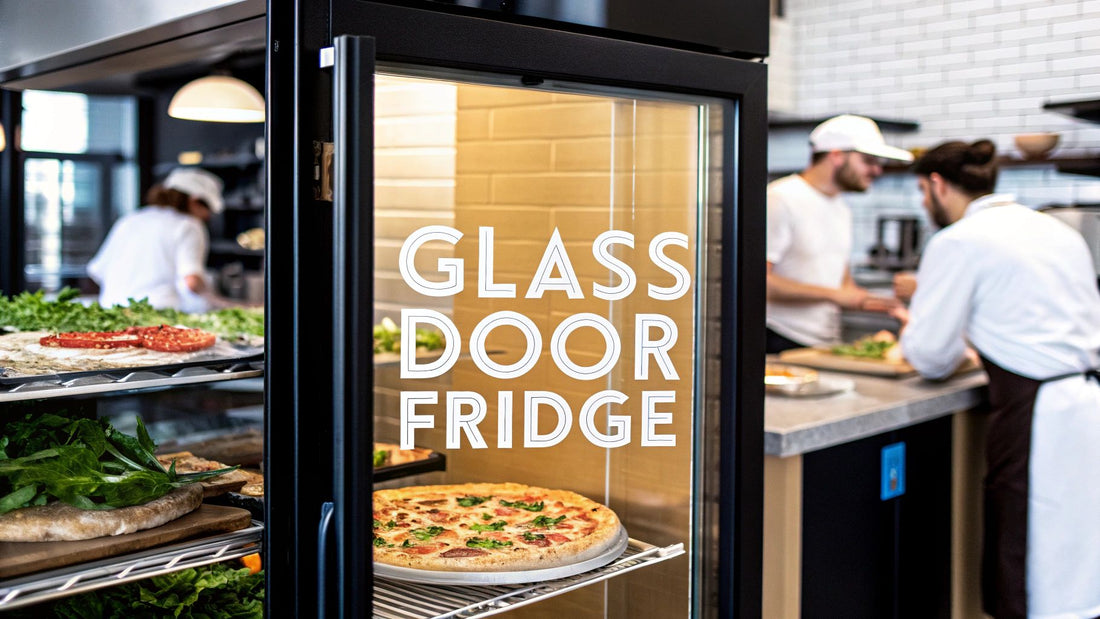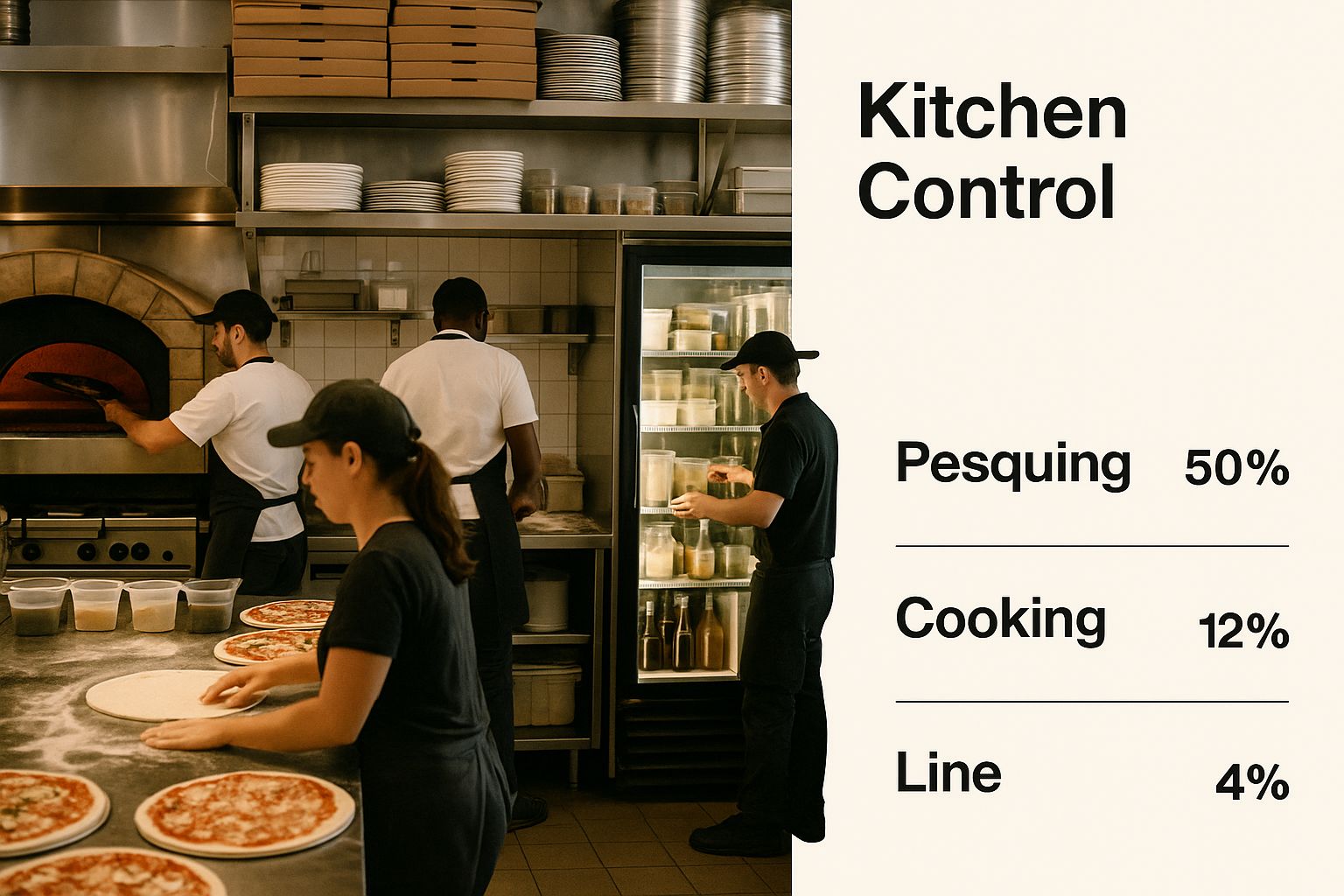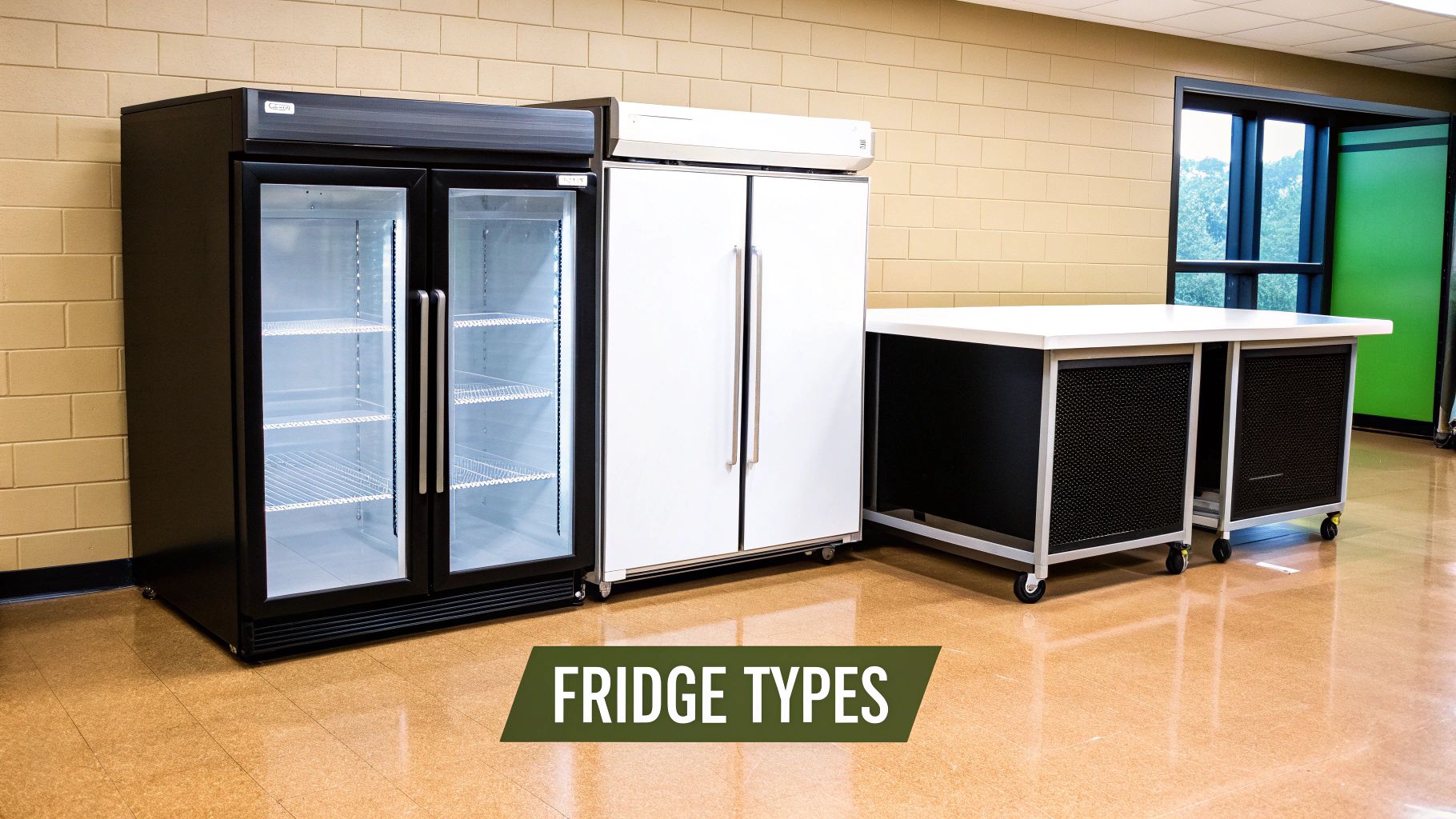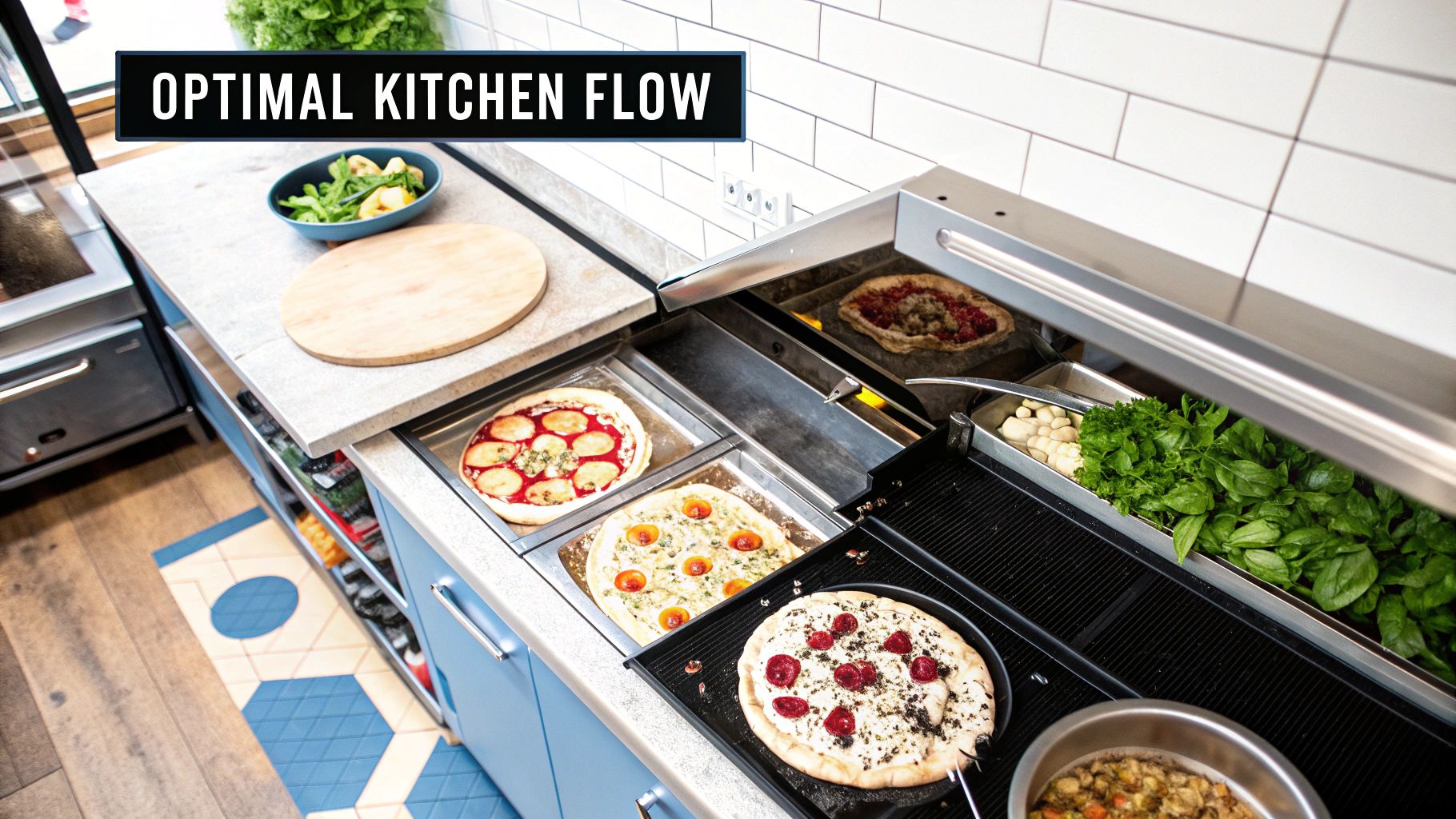
Choosing a Pizzeria Refrigerator with Glass Doors
Share
For a pizzeria, a refrigerator with glass doors isn't just a place to keep things cold. It's a critical tool for boosting workflow on the pizza prep line, keeping ingredients visible, and locking down food safety. These units are less like simple storage and more like operational hubs that let your team instantly find toppings and dough, which means the doors stay shut more often, and temperatures stay consistent—even during a chaotic dinner rush.
The Secret Ingredient to Pizzeria Efficiency
Think of your pizza prep line as an air traffic control tower. When the orders are flooding in, your kitchen crew has to land every single one perfectly and on time. A solid door refrigerator is like a tower with no windows—you know the planes (your ingredients) are in there somewhere, but you can't see them. Every time a cook yanks that door open, it’s a gamble that throws a wrench in the workflow.
This is where a glass door changes the entire game. It gives you a clear, real-time view of your entire inventory, turning that frantic search for pepperoni or mozzarella into a quick, precise grab-and-go. The result? A calmer, more organized kitchen where speed and consistency on the pizza prep table become the norm, not the exception.
Streamlining the Pizza Prep Process
A well-oiled prep station is the beating heart of any successful pizzeria, and a glass door unit acts as its command center. The advantages are immediate and obvious:
- At-a-Glance Inventory: Your crew can see stock levels of cheese, veggies, and meats without ever opening the door. This turns restocking the pizza prep table into a proactive task instead of a reactive scramble.
- Reduced Temperature Fluctuation: The less time that door is open, the more stable the internal temperature. That’s absolutely crucial for keeping perishable toppings in the safe zone.
- Faster Order Fulfillment: When cooks can see every ingredient laid out, they assemble pizzas faster. That means ticket times get slashed and customer satisfaction goes up.
The image below really drives home how a glass door refrigerator becomes the central hub in a busy pizzeria kitchen.

This setup isn't just about looking organized; it’s about creating a smooth, efficient flow of work. The growing demand for these units is obvious in market trends, too. The global market hit $13.7 billion in 2024 and is projected to climb to $19.8 billion by 2030, all because of how functional and visually appealing they are in commercial kitchens.
For a pizzeria, efficiency is profit. Every second saved on the prep line translates directly to more orders served and higher revenue. A glass door refrigerator is not a luxury; it's a fundamental tool for optimizing that process.
While the right kitchen equipment is vital, don't forget how professional presentation impacts your bottom line. Using a comprehensive guide to food photography and lighting for restaurants can seriously boost your pizzeria’s appeal and draw in more customers.
Figuring Out the Right Fridge for Your Pizza Prep Line
Not all commercial refrigerators are created equal, especially when you throw them into the chaos of a busy pizza prep line. Getting a handle on the key differences between the models out there is the first step to picking a unit that works for you, not against you. The three main players you'll be looking at are reach-in units, undercounter models, and those specialized pizza prep tables.
A reach-in refrigerator with glass doors is your workhorse for bulk storage. Think boxes of cheese, big tubs of sauce, and trays of prepped veggies. An undercounter model, on the other hand, slides right under your prep counter, giving you quick access to high-use toppings right where you're working. Then you have the dedicated pizza prep table, which is the whole package—refrigerated storage on the bottom with a refrigerated rail on top for ingredients.

Top-Mount vs. Bottom-Mount Compressors
Once you’ve settled on the style, the next big decision is where the compressor lives. This choice is a lot like picking tires for a car; you wouldn't put racing slicks on an off-road truck. For a pizzeria, this detail is absolutely critical.
A top-mount compressor sits on the roof of the unit, pushing hot air up and away. This is great for keeping the compressor out of the flour, dust, and general debris that lives on a kitchen floor. But in a hot pizzeria where heat naturally rises, it can end up sucking in that warmer air, forcing the unit to work overtime to stay cool.
On the flip side, a bottom-mount compressor is positioned at the base of the fridge. While it might seem more exposed to floor-level grime, it has a huge advantage: it pulls in cooler air from down low, making it way more energy-efficient in a hot kitchen. It also lifts the bottom shelf up, making it easier for your staff to grab what they need without constantly bending over.
For the vast majority of pizzerias, a bottom-mount compressor is the smarter choice. It runs more efficiently in a hot kitchen and is ergonomically better for your team, reducing strain during a long, busy shift.
Specialized units like pizza prep tables almost always use bottom-mount systems to maximize the valuable workspace on top. This design is also a key feature in many chef bases, which act as a refrigerated foundation for other cooking equipment. If you want to dive deeper, you can learn more about refrigerated chef bases in our guide and see how they can transform your kitchen layout.
Ultimately, the goal is to build a seamless workflow where every piece of equipment on your prep line helps you crank out quality pizzas faster. Choosing the right type of refrigerator with glass doors and the best compressor setup is the foundation for that success.
When you’re outfitting a pizzeria, you quickly realize that not all refrigerators are created equal. Moving past the basic models opens up a world of features designed specifically for the chaos of a high-volume kitchen. Choosing a refrigerator with glass doors isn't just about seeing what's inside; it's about investing in a tool that keeps your pizza prep table running like a well-oiled machine during the most intense dinner rush.
Think of this as your buyer's checklist for success. Certain features are simply non-negotiable in a pizzeria. They're the difference between a fridge that just stores ingredients and one that actively improves your workflow, prevents costly mistakes, cuts down on food waste, and helps your team move faster.
The Pizzeria Buyer's Checklist
When you're comparing models, you need to zero in on the features that solve the unique problems of a pizza kitchen. These aren't just "nice-to-haves"—they are absolutely essential for keeping up the pace and maintaining food safety.
Here’s what I tell every pizzeria owner to look for:
- Self-Closing Doors: In the heat of the moment, doors get left ajar. It happens. Self-closing doors are a critical failsafe, sealing shut automatically to keep temperatures consistent and food safe. This one feature can save you a fortune by preventing your compressor from burning out.
- Adjustable Shelving: Your storage needs are constantly changing. One day it's bulky dough boxes, the next it's deep pans of sauce and massive crates of cheese. Heavy-duty, adjustable shelves are a must-have for customizing the interior layout on the fly.
- High-Power Airflow Systems: Pizzeria fridges are opened constantly, letting cold air spill out. A powerful airflow system is what ensures rapid temperature recovery, snapping the internal climate back to a safe level after every opening and protecting your precious, perishable ingredients.
These are the core components that form the foundation of a truly reliable unit. But a few other details can take a refrigerator from just good to absolutely great.
Beyond the Basics: Essential Certifications and Lighting
Beyond the mechanics, you need to look for the features that guarantee compliance and make your team's life easier. An NSF rating, for instance, is non-negotiable. It's the seal of approval that confirms the unit is designed for easy cleaning and meets strict public health standards—something every single health inspector will be looking for.
For a pizzeria, bright, efficient lighting isn't a luxury. It's an operational tool that lets your staff identify ingredients in a split second, cutting down on errors and speeding up the entire pizza-making process.
This is exactly why you see modern commercial units decked out with brilliant LED lighting. This push for premium features is happening across the industry. The market for glass door merchandisers is projected to grow at a CAGR of 7.3% and hit over $20,188.7 million by 2035, and that growth is being driven by demand for things like low-E glass and advanced LEDs. You can discover more about the growth of the glass door merchandiser market and see how manufacturers are stepping up to meet commercial demands. When you put all these elements together, you get a refrigerator that doesn’t just work—it works for you.
Sizing and Placing Your Unit for Peak Kitchen Flow
Picking the right size and spot for your refrigerator with glass doors isn't about just filling an empty space—it’s about engineering a smarter, faster kitchen. Get it wrong, and you create bottlenecks that add precious seconds to every single order. But get it right? You can transform your pizza prep table into a well-oiled machine. It all comes down to understanding what your kitchen really needs.
Before you even start browsing models, you have to figure out your required internal capacity. A small café might do just fine with a compact unit, but a pizzeria cranking out orders has completely different demands. A solid rule of thumb is to plan for your peak hours. If your kitchen is pushing out 40 pizzas per hour during the dinner rush, you need a fridge that holds enough prepped ingredients to keep that pace without someone constantly running to the walk-in.

The Pizzeria Work Triangle
The most efficient kitchen layouts are all about minimizing how much your staff has to move. For a pizzeria, that means creating a seamless path from dough to oven. I like to call it the "pizzeria work triangle," a logical flow that your team follows for every order.
The ideal setup looks like this:
- Dough Station: This is where the magic starts—stretching and preparing the pizza base.
- Toppings Station: The refrigerated pizza prep table where sauce, cheese, and all the toppings get added.
- Oven: The final stop before the pizza gets boxed and handed to a happy customer.
Your refrigerator placement is the glue that holds this triangle together. A big reach-in unit loaded with bulk cheese and sauce should be positioned for easy restocking without getting in the way of the main prep line. Meanwhile, a smaller undercounter refrigerator should be built right into the toppings station itself, often as part of the pizza prep table.
By placing your refrigerated storage strategically, you eliminate wasted steps and create a direct, efficient path for every pizza. This simple change can dramatically slash prep times and bring a sense of calm to a chaotic kitchen.
For instance, an undercounter unit slid directly beneath the pizza prep table means your staff never has to walk away to grab more pepperoni. That kind of integration is absolutely crucial for maintaining speed. If you're thinking about this kind of setup, our guide on the benefits of an under-counter glass door refrigerator dives deeper into how these compact units can seriously boost productivity.
Ultimately, the goal is to make your kitchen layout feel intuitive. When your refrigerator with glass doors is in the perfect spot, your team moves less, works faster, and churns out more consistent, high-quality pizzas with a whole lot less stress.
Squeezing More Profit from Your Power Bill
Your commercial refrigerator is one of the hardest-working pieces of gear in your pizzeria. It never sleeps, running 24/7 to keep your ingredients fresh and safe. That constant grind makes it a huge chunk of your monthly utility bill, turning energy use into a serious operational cost.
This is exactly why choosing an energy-efficient refrigerator with glass doors isn't just a "green" decision—it's a brilliant financial move.
Think of an ENERGY STAR rating as your first checkpoint. These certified units are proven to be 15-20% more efficient than their standard counterparts. That’s not just a fancy sticker; it translates directly into real dollars saved on your power bill, month after month. Sure, the initial price tag might be a little higher, but the lower operating costs mean the unit starts paying for itself from day one.
The Secret Weapon: Low-E Glass
One of the most valuable features you'll find in an energy-efficient glass door refrigerator is Low-E (low-emissivity) glass. The easiest way to think about it is like a transparent thermal shield for your fridge.
This special, invisible coating acts like a bouncer at a club—it keeps the warm kitchen air out and lets the precious cold air stay inside where it belongs. By reflecting heat away from the glass, it drastically reduces the amount of work your compressor has to do. That means the unit cycles on less often, drinks less electricity, and ultimately, has a longer, healthier life. It's a simple piece of tech that delivers powerful, long-term savings.
A higher upfront cost for an energy-efficient model isn't an expense; it's a savvy long-term investment. The monthly savings on your utility bill compound over the life of the unit, delivering a substantial return.
This focus on efficiency is a huge deal in the industry. The global market for refrigerator glass doors was valued at a whopping $5.1 billion in 2023 and is expected to hit nearly $8.7 billion by 2032. You can learn more about these market trends to see how the demand for smarter technology is shaping the future of commercial kitchens.
Want to see what this looks like for your bottom line? Many ENERGY STAR resources have handy calculators to help you project your potential savings. For a deeper dive into running a lean, efficient kitchen, check out our guide on energy-efficient commercial refrigeration, which is packed with more tips specifically for pizzerias.
Simple Maintenance to Protect Your Investment
Think of your new glass-door refrigerator as a key player on your team. Like any valuable piece of equipment in your pizzeria, it needs a little TLC to perform at its best. Just 15 minutes of routine maintenance a week can be the difference between a smooth service and a costly emergency repair.
Taking care of your unit isn't just about preventing breakdowns—it's about protecting your bottom line. It slashes your energy bills, keeps your ingredients safe, and dramatically extends the life of your investment. Neglecting these simple tasks allows small issues, like a dusty coil or a leaky seal, to snowball into major problems that can shut down your pizza prep table right in the middle of a dinner rush.
Your Weekly Maintenance Checklist
Consistency is everything. Find a quiet time each week to run through these quick checks. It’s a proactive habit that keeps your unit humming, especially in a demanding kitchen where flour and grease are always in the air.
- Clean the Condenser Coils: In a pizzeria, flour dust is the enemy of your refrigerator's condenser coils. It clogs them up, forcing the compressor to work overtime and risk overheating. A quick vacuum or brush-off once a week is non-negotiable for maintaining proper airflow and efficiency.
- Wipe Down Door Gaskets: Grease and food crumbs can quickly degrade the rubber seals on your doors, causing them to crack or lose their grip. A weekly wipe with a damp cloth keeps them clean and pliable, ensuring a tight seal every single time.
- Check Temperature Calibration: Don't just trust the built-in display. Use a reliable external thermometer to double-check that the internal temperature is accurate. This simple step is vital for food safety and stops your unit from running too cold or too warm, which wastes energy.
Beyond the specific needs of your glass door refrigerator, a pizzeria operates under strict food service guidelines. Keeping all your equipment clean is critical, and you can learn more about maintaining hygiene standards in the hospitality sector to ensure your entire operation stays compliant and spotless.
Test Your Door Seals The Easy Way
A tiny gap in your door seal can leak a surprising amount of cold air, driving up your energy costs. Try the "dollar bill test": close the door on a dollar bill. If you can pull it out with zero resistance, your seal is too loose. The gasket likely needs to be adjusted or replaced.
Your Top Questions About Glass-Door Pizzeria Refrigerators
Even after seeing all the benefits, I get it. Pizzeria owners always have those practical, "what-if" questions about how a refrigerator with glass doors will actually hold up in a real, high-stress kitchen. Let's tackle the big ones I hear all the time to clear up any doubts you might have.
The number one worry is always about that Friday night dinner rush. Can a glass door unit really keep its cool when it’s being opened every thirty seconds?
Will a Glass Door Refrigerator Hold Temperature During a Busy Service?
Absolutely. A quality commercial glass door refrigerator is engineered for exactly this scenario. These aren't your average breakroom fridges; they’re built with powerful compressors, robust internal fans that circulate cold air, and heavy-duty, self-closing doors with tight seals.
All these parts work together to help the temperature snap back to its set point almost instantly after the door closes. This ensures your cheese, pepperoni, and fresh veggies stay safely chilled and well within food safety guidelines, even during the craziest rush at the pizza prep table.
Another question that always comes up is about that classic kitchen headache: condensation.
The secret to fighting condensation is in the glass itself. Modern units use double or even triple-pane thermal glass, often filled with argon gas and treated with anti-fog coatings. This creates a powerful barrier between the cold interior and the warm, humid air of your kitchen.
This technology is designed to minimize moisture buildup, keeping the glass crystal clear so your team can see what’s inside at a glance. When you're shopping, make sure to ask about the unit's specific anti-condensation features. After all, visibility is the whole point of getting a glass door model.
Many owners also wonder if the glass is just one more thing to clean. It's actually not a big deal. While you'll give the glass a quick wipe-down to handle fingerprints, the overall cleaning is no different than a solid door model. The trade-off is huge; spotting a spill or a disorganized shelf immediately usually means the inside of the fridge stays much cleaner. Plus, look for models with removable door gaskets—they make deep cleaning a breeze.
Finally, the big one for any pizzeria: can you store dough in it? Of course. A refrigerator with glass doors is perfect for proofing dough boxes. It provides the consistent temperature and humidity dough needs to develop properly. And that clear view is a massive advantage, letting your staff check on the dough's progress without ever opening the door and messing with the internal climate.
Ready to find the right refrigeration for your pizzeria? Check out the huge selection of high-performance pizza prep tables and commercial refrigerators over at Pizza Prep Table. Visit https://pizzapreptable.com and get your kitchen set up for success.
